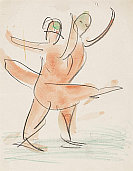
Peter Candid (Candido)
München
1628
Born in Bruges in 1548, Peter Candid was taken as a child to Florence in 1558, where his father, the tapestry-maker Pieter de Witte, worked at the tapestry manufactory. The family now assumed the surname Candido and the young painter called himself Pietro di Pietro Candido, preferring the Italian form of the name for the rest of his life. Peter Candid probably trained in Florence during the 1560s although no names of teachers are known. Peter Candid is mentioned for the first time in records in 1569 in connection with a fresco in the Chapel di S. Luca, where the Florentine Accademia del Disegno buried its dead. Candid has been verified as a member of the Florentine Accedemia del Disegno for 1576; after returning from a year's stay in Rome he was designated "Accademico" in 1583.
Carel van Mander, whom Peter Candid met in Florence in 1574, described him as an accomplished fresco and oil painter who could also model in clay. Carel von Mander recorded that Candid was one of the painters who worked for Giorgio Vasari on decorating the Sala Regia in the Vatican and in painting the dome of Florence Cathedral as well as designing tapestries for the Medici. These works, for which there is no further verification, must have been done before 1574.
Peter Candid's style was initially influenced less by Vasari than by painters like Bronzino and Alessandro Allori but about 1580 Candid began to look back at the High Renaissance. A Netherlandish influence is apparent in Peter Candid's later designs for tapestries as well as his style of drawing. In 1586 Candid was summoned to Munich by Duke Wilhelm V of Bavaria on the recommendation of Giovanni Bologna (Giambologna), where he soon advanced to the top echelon of the artists and artisans working for the Bavarian court.
Peter Candid's early Munich work consisted in altarpieces, including one for St Michael's. During the reign of Maximilian I, Candid's field of activity broadened: from 1604 he was responsible for designing and making four important tapestry cycles. From 1612 Candid supervised the painting of the Residenz interior in Munich and of the Alter Schloss at Schleißheim. In 1619 Peter Candid designed a painting for the Goldener Saal in Augsburg Town Hall.
Candid's versatility induced Joachim von Sandrart to describe him as a "universal painter". In addition to the fine painting so popular in Mannerism, Peter Candid painted landscapes and portraits while continuing to work on altarpieces. Candid's compositions, especially his Annunciations, were frequently imitated and his paintings were often reproduced as engravings.
The high point of Candid's last work was the main panel of the high alter formerly in the Munich "Frauenkirche", an "Assumption of the Virgin" (1620). It reveals that Peter Candid was by then working in the Early Baroque style. Peter Candid died in March 1628 in Munich in March 1628. About one hundred and thirty Candid designs and detail studies for paintings, tapestries and prints survive.
No objects available at present
Would you like to sell a work by Peter Candid (Candido)?
Infos for seller




